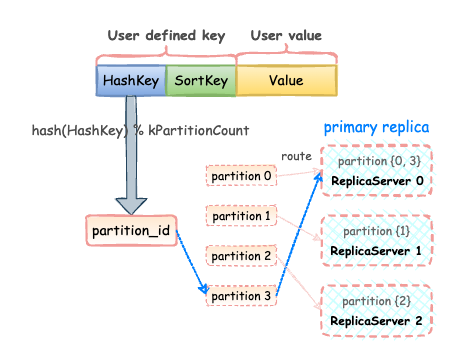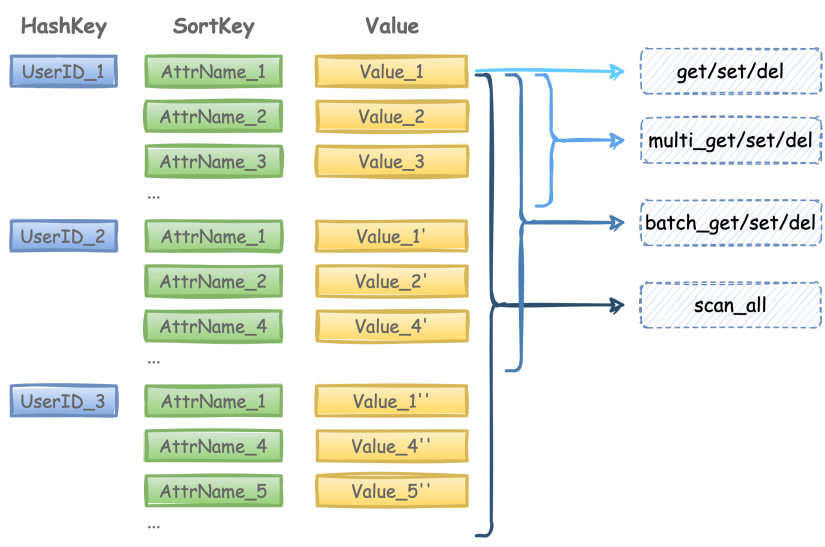Data Model
Introduction
The data model of Pegasus is a simple Key-Value model, it does not support complex schemas. However, to enhance its expressive power, Key is split into HashKey and SortKey, namely composite key ([HashKey, SortKey] ->Value), which is similar to DynamoDB’s composite primary key.
HashKey
Byte string. Similar to the partition key in DynamoDB, HashKey is used to calculate which partition (a.k.a. shard) the data belongs to. Pegasus uses a specific hash function to calculate the hash value for a HashKey, and then modulo the number of partitions to obtain the Partition ID for the data. Therefore, data with the same HashKey is always stored in the same partition.
Note: On the C++ client side, the HashKey length limit is 64KB. On the Java client side, if WriteLimiter is enabled, then the limit is 1KB. On the server side, since Pegasus 2.0.0, if
[replication]max_allowed_write_sizeis set as non-zero, limit the size of the entire request packet to this value, defaulting to 1MB.
SortKey
Byte string. Similar to the sort key in DynamoDB, SortKey is used for sorting data within a partition. In fact, when storing data internally in RocksDB, we concatenate HashKey and SortKey as the keys of RocksDB.
Note: On the C++ client side, there is no limit to the length of SortKey. On the Java client side, if WriteLimiter is enabled, then the limit is 1KB. On the server side, since Pegasus 2.0.0, if
[replication]max_allowed_write_sizeis set as non-zero, limit the size of the entire request packet to this value, defaulting to 1MB.
Value
Byte string.
Note: On the C++ client side, there is no limit to the length of the Value. On the Java client side, if WriteLimiter is enabled, then the limit is 400KB. On the server side, since Pegasus 2.0.0, if
[replication]max_allowed_write_sizeis set as non-zero, limit the size of the entire request packet to this value, defaulting to 1MB.

Pegasus vs. HBase
Although Pegasus is not as semantically rich as HBase’s tabular model, it can still meet most applications’ needs, thanks to its HashKey+SortKey combination key design.
For example, users can treat HashKey as a row key and SortKey as an attribute name or column name, so that multiple data of the same HashKey can be viewed as one row, which can also express the concept of row in HBase.
Taking this into consideration, Pegasus not only provides the get/set/del interface for accessing individual data, but also provides the multi_get/multi_set/multi_del interfaces for accessing batch data in the same HashKey, and these interfaces provide single line atomic semantics, making it convenient for users to use.

Pegasus vs. Redis
Although Pegasus does not support rich data structures such as List/Set/Hash like Redis, users can still use Pegasus to implement similar semantics.
For example, users can equate HashKey with Redis’ key and use SortKey as the field of Hash (or member of Set) to implement Hash in Redis.